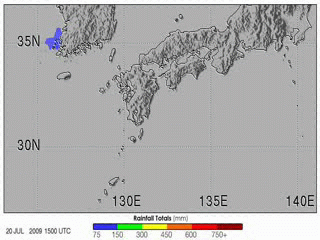Dosya:Heavy Rains in Southern Japan.gif
Heavy_Rains_in_Southern_Japan.gif (320 × 240 piksel, dosya boyutu: 8,35 MB, MIME türü: image/gif, döngüye girdi, 268 kare, 8,0 sn)
Not: Teknik sınırlamalar nedeniyle, bu gibi yüksek çözünürlüklü GIF resimlerinin küçük resimlerinde animasyon yoktur.
Dosya geçmişi
Dosyanın herhangi bir zamandaki hâli için ilgili tarih/saat kısmına tıklayın.
| Tarih/Saat | Küçük resim | Boyutlar | Kullanıcı | Yorum | |
|---|---|---|---|---|---|
| güncel | 23.56, 31 Temmuz 2009 |  | 320 × 240 (8,35 MB) | wikimediacommons>Originalwana | {{Information |Description={{en|1=The 2009 summer monsoon brought torrential rains to south western Japan in July. This animatin shows rainfall estimates for southern Japan and the surrounding region from July 20–27. The most prominent feature is a larg |
Dosya kullanımı
Aşağıdaki sayfa bu dosyayı kullanmaktadır:


